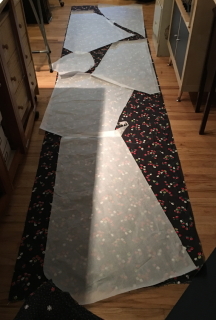Twisted Dress
26 Mar 2019 08:26 amThis was another exercise in translating.
This is the Twisted Dress from the Japanese sewing book "Garments of a Dignified Lady" by Koji Takiguchi (2014) published by Bunka.
The second-most challenging aspect of this dress was fusing the tape onto the armholes and neck edge. On very shifty fabric. Fortunately, I got help with that from
The dress is made from two layers - polyester georgette and sandwashed rayon - twisted at the hem before sewing together.
It went together pretty simply and quickly, and I noticed that some of the construction techniques were used in RTW, like the armhole finishing.
The sandwashed rayon is luxurious and I miss those rayons from the 90s. Very heavy and drapey.
I forgot to try this on before completely sewing it up. It would have been pretty easy to do that with just the lining. Instead, I found out after the second-to-last step of mostly sewing the hem that the armholes are pretty low. LOW. I added at 3" high gusset to the underarm by taking apart the main fabric and lining and sewing the main-fabric-and-lining-double-layer gusset to each layer separately (so the dress could still twist). However, I could have just sandwiched the gusset between the two layers and sewn them all together and it would have been fine, as the dress would still twist.
The hem is what gives the dress the twist and bubble hem - you layer the dress wrong sides together, and bring the left side seam to the right side seam at the hem, and sew them together, leaving an opening to turn the dress right side out. Which it already was? I had to put this down and talk a walk to figure it out in my head before doing it. It worked, but I'm still not entirely sure how.
If I make it again, I would probably add about 1/4" in width to the outside armholes. This could be fun with contrasting colors of lining and sheer main fabric.
I like it because it's very comfortable, but I'm not sure about the bag shape on me.






